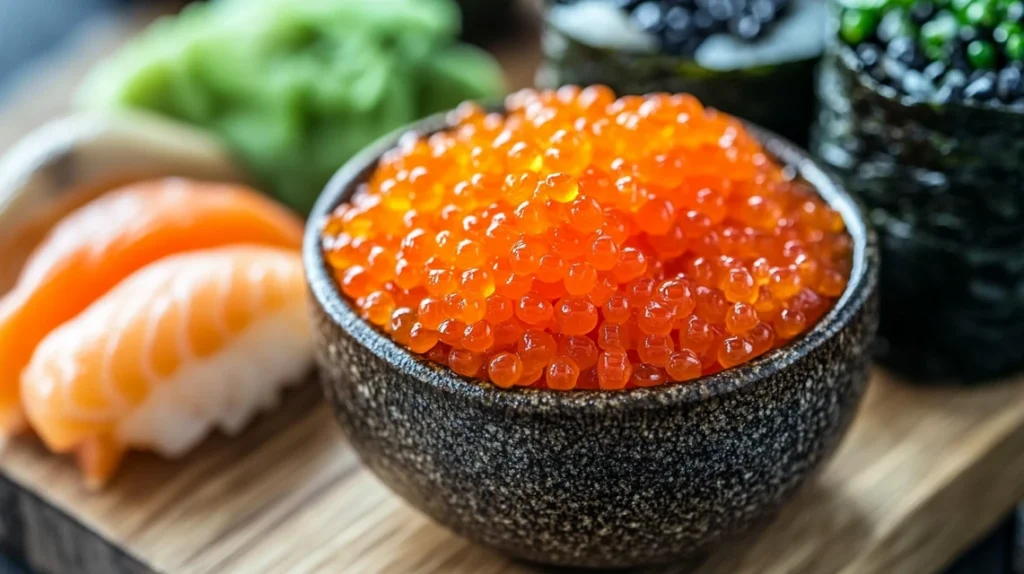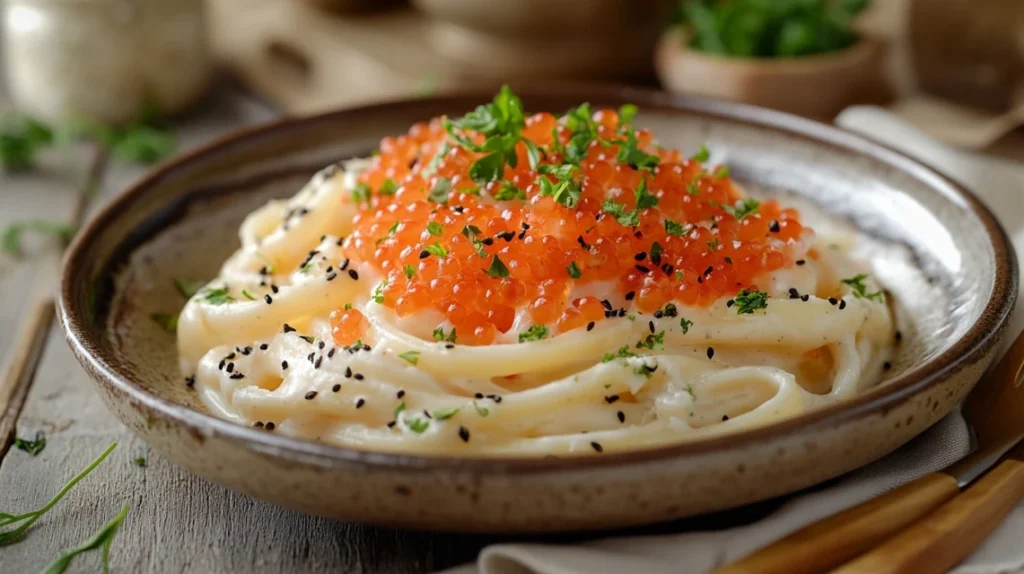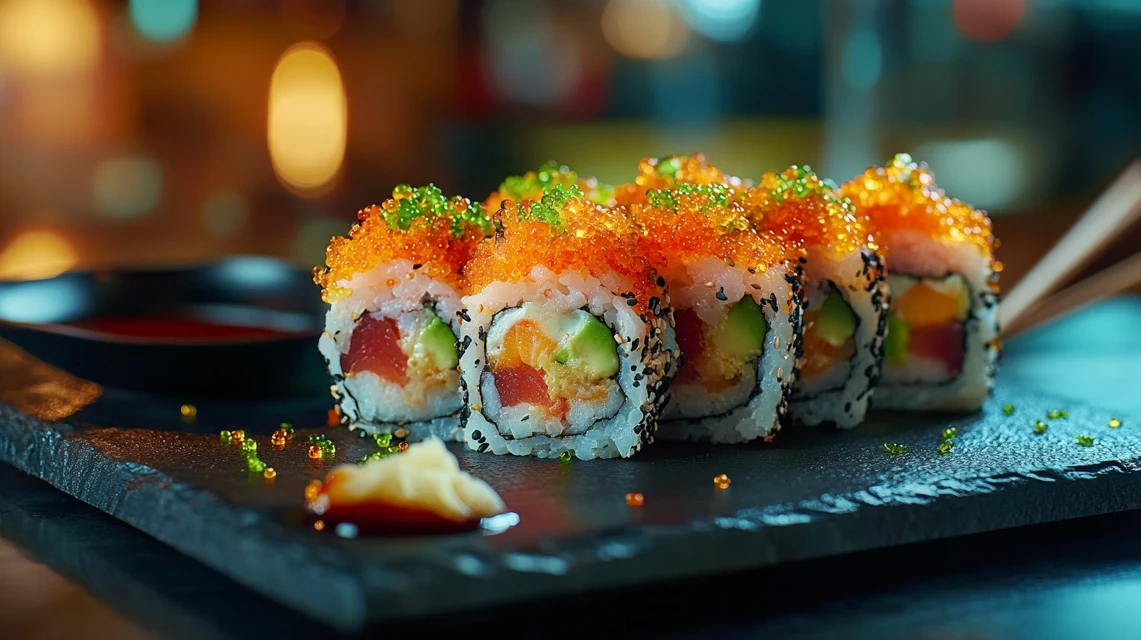Tobiko, or flying fish roe, offers vibrant colors, a crunchy texture, and unique flavors that make it a tiny treasure of the sea. This guide helps you explore everything about tobiko, from its types and preparation to its nutritional benefits and culinary uses. Whether you love sushi or feel curious about this seafood delight, you’ll discover why tobiko has become so popular worldwide.

“A detailed image of colorful tobiko varieties, perfect for sushi-making, highlighting its natural beauty.”
What is Tobiko?
Tobiko, a Japanese term for flying fish roe, adds vibrant colors and a crunchy texture to sushi dishes. These tiny eggs not only enhance rolls and garnishes but also bring a burst of flavor to every bite.
Types of Tobiko
Tobiko is available in several vibrant colors and flavors, making it a versatile ingredient that enhances both the taste and appearance of dishes. Each type of tobiko brings something unique to the table, offering a variety of culinary experiences.
Varieties of Tobiko Based on Color
- Orange Tobiko: The most common type, known for its bright color and mildly sweet taste. It’s a staple in sushi rolls and is what many people picture when they think of tobiko.
- Black Tobiko: Colored with squid ink, this variety has a bold look and a slightly saltier flavor. It’s perfect for dishes requiring a dramatic visual element.
Other colors include:
- Red Tobiko: Enhanced with beet juice or other natural colorants for a striking appearance.
- Green Tobiko: Often flavored with wasabi, offering a spicy kick that complements its natural crunch.
Other Varieties and Flavors
In addition to natural and color-enhanced tobiko, there are specialty-infused varieties:
- Wasabi Tobiko: Green and spicy, it’s a favorite for adding zest to sushi.
- Yuzu Tobiko: A citrus-infused option that delivers a tangy twist, making it ideal for seafood dishes.
Tobiko’s ability to adapt to different cuisines and flavor profiles makes it a favorite for chefs experimenting with fusion recipes.
How Tobiko is Made
Ever wondered how tobiko goes from the ocean to your plate? This process involves careful harvesting, preparation, and flavoring to ensure every bite is delightful.
Harvesting Flying Fish Roe
Flying fish, primarily found in tropical and subtropical waters, provide the roe for tobiko. Fishermen use fine nets to collect the roe, ensuring minimal damage. Consequently, this method preserves the quality of the product.
Processing and Preparation
Once harvested, the roe undergoes a detailed preparation process:
- Cleaning: Workers wash the eggs to remove impurities.
- Curing: They cure the eggs with salt and sometimes sugar to preserve and enhance their flavor.
- Coloring and Flavoring: Producers add natural or artificial colorants, along with seasonings like soy sauce or wasabi, to create different varieties.
Here’s a simplified look at the ingredients and their quantities used during preparation:
| Ingredient | Quantity |
|---|---|
| Flying Fish Roe | 1 kg |
| Salt | 30 g |
| Sugar | 10 g |
| Natural Colorants | As needed |
Tobiko is then packaged and shipped to sushi bars and supermarkets worldwide, ready to add a pop of flavor and color to your favorite dishes.
Nutritional Value of Tobiko
Eating tobiko is not just a treat for your taste buds; it can also be a nutritious addition to your diet. Packed with essential nutrients, tobiko offers several health benefits while being relatively low in calories.
Tobiko is an excellent source of:
- Protein: With around 4 grams per ounce, it’s great for muscle repair and growth.
- Omega-3 Fatty Acids: These healthy fats support heart health and brain function.
- Vitamin B12: Tobiko contains about 1.5 micrograms of B12 per serving, helping with energy levels and red blood cell production.
Potential Health Concerns
While tobiko offers many benefits, there are a few things to keep in mind:
- High Sodium Content: At around 200 mg per ounce, tobiko can contribute to your daily sodium intake. If you’re watching your salt consumption, enjoy it in moderation.
- Allergy Risks: People allergic to fish or seafood should avoid tobiko, as it can trigger allergic reactions.
Comparing Tobiko with Other Fish Roe
When it comes to fish roe, flying fish eggs aren’t the only option. Let’s compare this popular ingredient with its close relatives, such as caviar and masago, to understand what makes it unique.
For more seafood recipes, check out our Seafood Recipes Collection
Flying Fish Roe vs. Caviar
- Taste and Texture: Flying fish roe is smaller, crunchier, and has a mild flavor, whereas caviar is celebrated for its luxurious, buttery taste.
- Price: This roe is far more affordable than caviar, making it accessible to a wider audience.
- Culinary Use: While caviar is typically served as a standalone delicacy, flying fish roe stands out as a vibrant topping or ingredient in sushi, pasta, and other dishes.
Flying Fish Roe vs. Masago
Masago, or capelin roe, is often mistaken for flying fish eggs due to their similar appearance. However, there are distinct differences:
- Size and Texture: Flying fish roe is slightly larger and crunchier, while masago is smaller and softer.
- Flavor: Masago has a more subtle taste, which makes it less prominent in dishes compared to the bold flavor of flying fish eggs.
- Cost: Masago is usually less expensive but doesn’t offer the same vibrant colors or intense flavor variety.
How to Use Tobiko in Dishes
Flying fish roe is a versatile ingredient that brings flavor, texture, and vibrant colors to a variety of recipes. From traditional Japanese meals to innovative modern dishes, this seafood delicacy has become a favorite among chefs and food lovers alike.
Traditional Japanese Recipes
- Sushi Rolls: Flying fish roe is a staple in sushi, providing a crunchy texture and vibrant color to popular options like California rolls and spicy tuna rolls.
- Gunkan-Maki: This “battleship sushi” features roe piled high on rice and wrapped in seaweed, showcasing its unique appearance.
- Rice Bowls: Sprinkling this ingredient over steamed rice or chirashi (scattered sushi) creates an easy yet flavorful dish.
These classic uses demonstrate how this ingredient elevates simple, elegant meals.
Modern Culinary Innovations

- Creamy Pasta: Adding roe to a creamy pasta dish introduces a crunchy texture and a pop of briny flavor. The contrast between the orange roe and pale sauce also enhances the dish’s visual appeal.
- Fusion Tacos: Fusion-inspired recipes often use roe as a garnish, offering a salty crunch and a unique twist to traditional tacos.
- Seafood Pizzas: On pizzas, these tiny pearls provide a surprising burst of flavor that pairs wonderfully with seafood toppings.
Frequently Asked Questions About Tobiko
Are you curious about flying fish roe? Here are some of the most common questions people have about this vibrant seafood delicacy:
What Color is Caviar Compared to Tobiko?
Caviar is usually dark gray to black, while flying fish roe comes in bright colors such as orange, black, green, and red. These vibrant hues make it visually striking and easy to differentiate from caviar.
Are These Real Fish Eggs?
Yes, this roe is harvested from real flying fish. Unlike imitation or synthetic alternatives, it’s a natural product sourced from tropical and subtropical waters.
Is It Healthy to Eat Flying Fish Roe?
Absolutely! This seafood is low in calories and packed with protein, omega-3 fatty acids, and vitamin B12. However, because it contains sodium, moderation is advised.
What is the Difference Between Orange Caviar and Flying Fish Roe?
The term “orange caviar” is sometimes used to describe this roe due to its vibrant hue. However, true caviar comes from sturgeon, while flying fish roe has a crunchier texture and lighter taste, making it ideal for sushi and modern recipes.
Where to Buy Tobiko
Finding flying fish roe has become easier than ever, thanks to its growing popularity in global cuisine. Whether you’re shopping locally or online, there are plenty of options to get high-quality roe for your meals.
Sourcing Locally
- Grocery Stores: Many Asian markets and specialty grocery stores carry flying fish roe, often in the freezer section. Be sure to check the seafood aisle or ask a store employee for assistance.
- Fish Markets: Some fish markets offer fresh roe, which can be a great option if you’re planning to use it right away.
When buying locally, always inspect the packaging. High-quality roe should have vibrant colors and a fresh, slightly briny scent.
Buying Online
If you can’t find flying fish roe nearby, online retailers are a convenient alternative:
- Specialty Seafood Stores: Websites that focus on Japanese ingredients often ship frozen roe directly to your door.
- Subscription Services: Some gourmet food subscriptions include roe as part of their offerings, ensuring freshness and variety.
Storing and Handling Tobiko
Proper storage and careful handling are essential for maintaining the flavor and freshness of this vibrant seafood ingredient.
Proper Storage Techniques
- Refrigeration: Fresh roe should be stored in the refrigerator and consumed within 3–5 days for the best quality.
- Freezing: For extended storage, freeze the roe in an airtight container to prevent freezer burn. It can stay frozen for up to three months without losing its texture or flavor.
Learn more about storing seafood effectively in our Special Old Fashioned Salmon Patties Recipe
Maximizing Shelf Life
- Portion Control: Divide the roe into smaller portions before freezing, so you only defrost what you need for each use.
- Quick Thawing: Thaw frozen roe gradually in the refrigerator for a few hours. Avoid thawing at room temperature or using a microwave, as these methods can negatively affect its texture.

Tobiko Sushi
Equipment
- Bamboo Sushi Mat
Ingredients
Sushi Rice
- 1 cup sushi rice uncooked
- 1 1/4 cups water
- 2 tbsp rice vinegar
- 1 tbsp sugar
- 1/2 tsp salt
Tobiko Sushi
- 4 sheets nori (seaweed sheets) cut in half
- 100 g tobiko (flying fish roe)
- wasabi optional
- soy sauce for dipping
Instructions
- Rinse the sushi rice under cold water until the water runs clear.
- Cook rice with water according to package instructions or using a rice cooker.
- While rice is hot, mix in rice vinegar, sugar, and salt. Let cool to room temperature.
- Place a half sheet of nori on the bamboo mat, rough side up. Spread a thin layer of rice, leaving 1 cm at the top edge.
- Add a small amount of wasabi if desired. Top the rice with tobiko.
- Roll the sushi tightly using the bamboo mat. Slice into bite-sized pieces.
- Serve with soy sauce and additional wasabi if desired.
Notes
Conclusion
Flying fish roe is more than just a colorful garnish for sushi it’s a versatile, nutritious, and delicious ingredient that adds flair to both traditional and modern dishes. From its vibrant varieties to its nutritional benefits and culinary uses, this ingredient has earned its place as a favorite in kitchens around the world.
Whether you’re making sushi at home, experimenting with fusion recipes, or simply exploring new flavors, it’s a small ingredient that makes a big impact.
So, the next time you see it in a dish, you’ll not only enjoy its taste but also appreciate the journey it took from the ocean to your plate.
